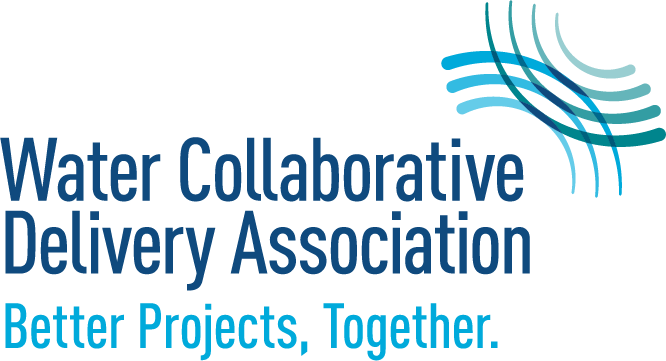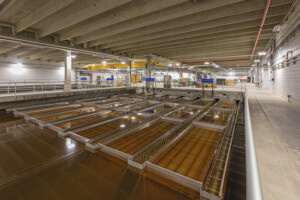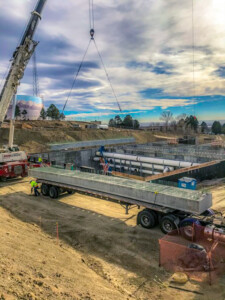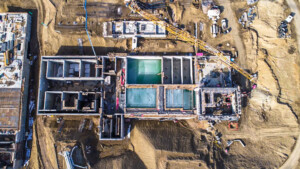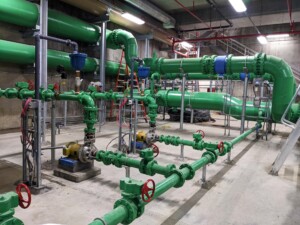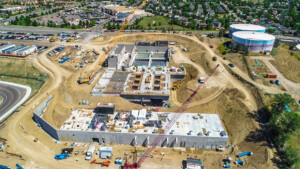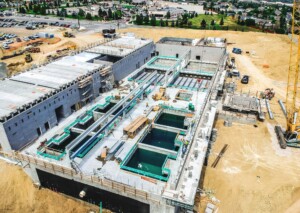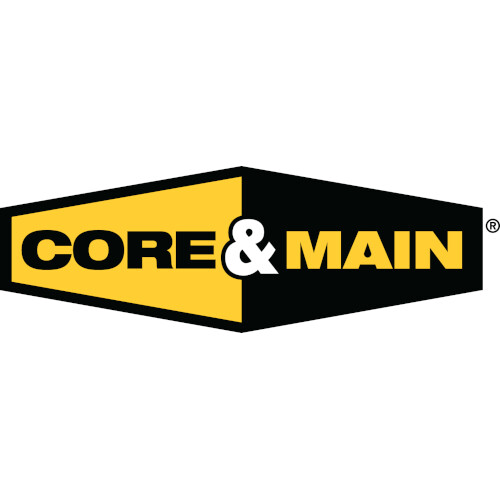Challenge
Thornton, CO, is experiencing rapid growth and anticipates reaching full buildout by 2065 with an expected population of around 250,000 residents and 269,000 water customers. With such a rapid growth curve, the City of Thornton knew it had to replace its aging 20 mgd conventional drinking water plant. The plant had been in service since 1955, predating the city’s incorporation. It had now reached the end of its useful life, and was incapable of treating all of Thornton’s various source waters due to its simple process limitations.
In 2015 the City began in earnest to plan for a new water treatment plant. It needed to be resilient and robust enough to meet water demands 365 days a year, including winter water temperatures of 4°C. It needed to be flexible enough to treat the multiple source waters Thornton has in its portfolio to Partnership for Safe Water standards. It also needed to have a robust taste and odor treatment system to mitigate algae-sourced challenges within Thornton’s raw water storage reservoirs. This was a key part as taste and odor were the biggest complaints of Thornton customers.
Burns & McDonnell designed a treatment facility incorporating ozone and biologically active filtration treatment processes that specifically target odor removal and taste. The facility also houses piping and accommodations to treat a third water source in the future, fed from northern Colorado.
To provide operational flexibility, Burns & McDonnell designed the new Thornton Water Treatment Plant (TWTP) with a raw water blending room so that operators can isolate or blend the water sources coming into the plant. Having multiple chemical injection points throughout the treatment train aids in operational flexibility and creates opportunities for cost savings on chemicals. This feature, combined with strategically placed instrumentation, allows Thornton to quickly respond to significant variations in water source quality. The plant also has hydraulic capacity for emergency treatment during high-flow periods.
Approach
The City of Thornton selected progressive design-build (PDB) as its project delivery method for several reasons. Time was a driving factor and the City felt that PDB would allow early work packages to be released, saving time and accelerating the project delivery schedule. In fact, the project completed 12 months sooner than originally forecasted.
PDB also allowed the City to determine construction budgets and overall project budgets sooner than they would have if they had used traditional design-bid-build. The City also determined that PDB would enhance project scope and decrease scope changes and change orders during construction.
The City used a two-step procurement process in which qualifications and relevant experience were the primary evaluation factors in selecting the design-builder. The procurement documents explicitly stated that they preferred an experienced contractor-led team that had delivered water treatment projects of similar size and complexity using collaborative delivery. The City provided proposers a conceptual design report that clearly stated the project goals and objectives, provided existing conditions and site constraint information, included water quality and other performance requirements, and described an indicative design for the new treatment facility. The purpose of the indicative design was to establish minimum technical requirements and owner preferences while allowing the proposers and eventual design-builder to develop a design based on their ideas and engineering judgment. A confidential meeting was held during procurement for proposers to discuss their innovative ideas relative to the indicative design, and to provide comments on the draft design-build agreement provided with the RFP. The City ultimately selected Garney Construction and Burns & McDonnell as their design-builder. Ferguson helped Garney provide cost estimates during the design phase and supplied a good portion of the pipe, valves, and fittings on the project.
The City and PDB team continually refined cost and schedule at various points of design completion at the 30%, 50%, and 80% phases. This allowed the City to have firm costs at the 80% design level and the confidence to convert the contract from a guaranteed maximum price (GMP) to lump sum at this stage. The project was successful in meeting both the overall project schedule and project budget.
Results
The TWTP is a prime example of how innovative design and construction solutions can help communities achieve resiliency to water scarcity and treatment challenges. It is one of only a handful of facilities in Colorado to use ozone and biofiltration to treat drinking water for taste and odor on a greenfield site.
Thornton has adopted policies that will adhere to higher treatment standards than required by current regulations. Design features of the new TWTP allow Thornton to meet its Partnership for Safe Water, Phase IV goals, a voluntary self-assessment program administered by the AWWA that focuses on rigorous data collection and reporting as a means of holding utilities to the highest standards of public health and safety for water quality. The TWTP exceeds the goals laid out by this program and serves as an example of success to other communities.
Thornton is especially pleased with the new TWTP’s ability to isolate and blend water sources and its ability to provide additional emergency capacity. Since the flocculation and sedimentation processes were designed around very cold viscous water, it allowed the team to pilot and receive approval for a higher filtration rate. Thornton can take advantage of this additional production capacity during a peak summer water demand when the lower viscosity of the water will have a less negative effect on the floc/sed systems.
Awards:
• 2021 Best Projects Award of Merit – Water/Environment category, Engineering News-Record
• 2022 Merit Award, ACEC Colorado
“The exceptional teamwork between Thornton, Burns & McDonnell, and Garney resulted in a great project. The design-build team delivered a successful project that not only met our budget, schedule, and treatment goals, but that was delivered within budget and a year sooner than what we could have achieved using traditional design-bid-build delivery, even in the midst of a pandemic.”
– Martin Kimmes, City of Thornton
